Development of an Integrated Patient Management System for Headspace
VerifiedAdded on 2019/11/19
|5
|1124
|522
Project
AI Summary
This project focuses on the development of an integrated patient management system for Headspace, an organization providing emotional support to mentally ill youths. The project begins with an introduction highlighting the need for a system to streamline patient information and reduce repetitive storytelling. A stakeholder map is presented, identifying internal and external stakeholders based on their influence and importance. The project then details a questionnaire designed to gather requirements from Headspace workers, followed by a use case analysis diagram describing key functionalities such as login, patient management, and appointment scheduling. A detailed use case description for scheduling patient appointments is provided, including actors, preconditions, normal and alternative flows, and special requirements. The project concludes with a list of references.
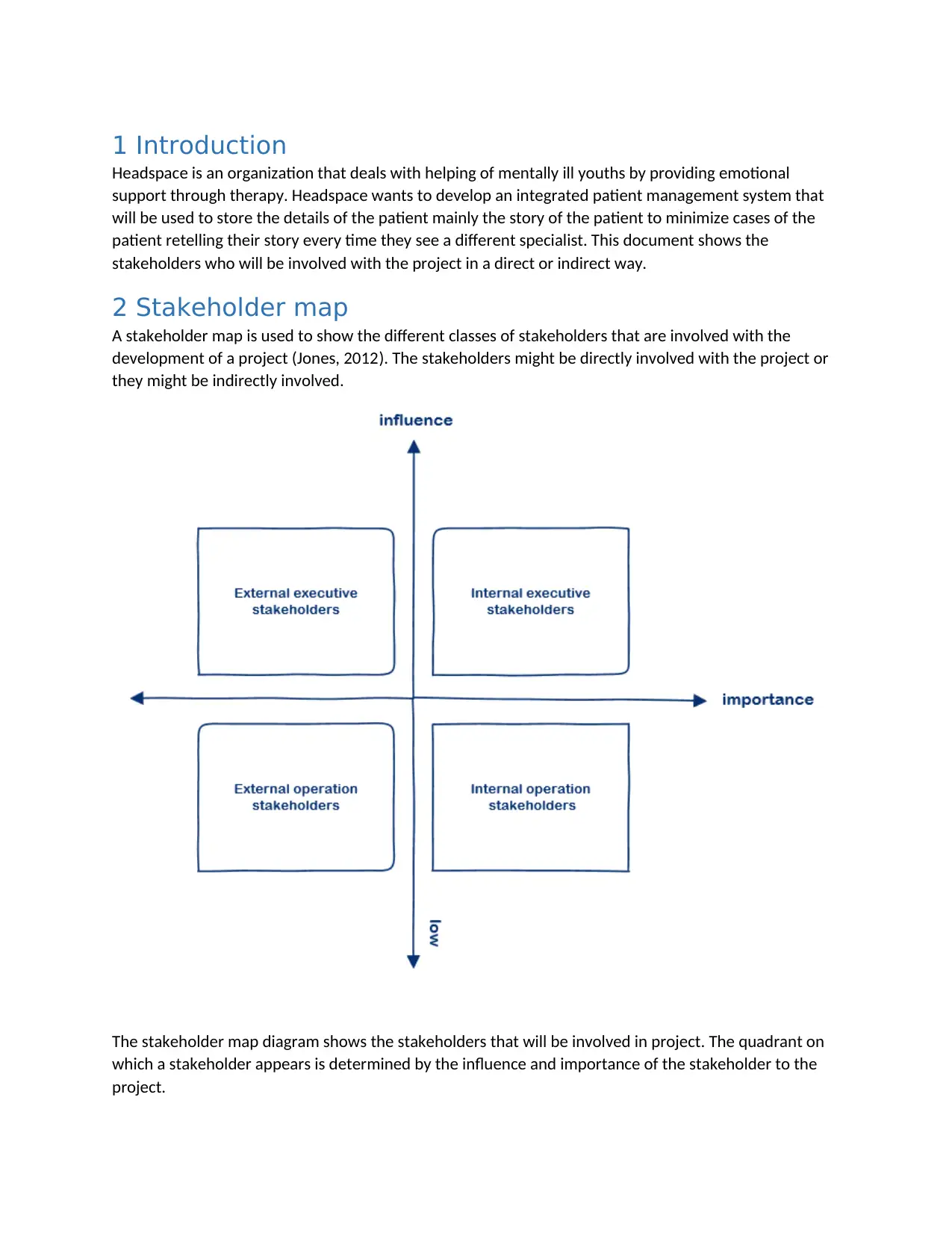
1 Introduction
Headspace is an organization that deals with helping of mentally ill youths by providing emotional
support through therapy. Headspace wants to develop an integrated patient management system that
will be used to store the details of the patient mainly the story of the patient to minimize cases of the
patient retelling their story every time they see a different specialist. This document shows the
stakeholders who will be involved with the project in a direct or indirect way.
2 Stakeholder map
A stakeholder map is used to show the different classes of stakeholders that are involved with the
development of a project (Jones, 2012). The stakeholders might be directly involved with the project or
they might be indirectly involved.
The stakeholder map diagram shows the stakeholders that will be involved in project. The quadrant on
which a stakeholder appears is determined by the influence and importance of the stakeholder to the
project.
Headspace is an organization that deals with helping of mentally ill youths by providing emotional
support through therapy. Headspace wants to develop an integrated patient management system that
will be used to store the details of the patient mainly the story of the patient to minimize cases of the
patient retelling their story every time they see a different specialist. This document shows the
stakeholders who will be involved with the project in a direct or indirect way.
2 Stakeholder map
A stakeholder map is used to show the different classes of stakeholders that are involved with the
development of a project (Jones, 2012). The stakeholders might be directly involved with the project or
they might be indirectly involved.
The stakeholder map diagram shows the stakeholders that will be involved in project. The quadrant on
which a stakeholder appears is determined by the influence and importance of the stakeholder to the
project.
Paraphrase This Document
Need a fresh take? Get an instant paraphrase of this document with our AI Paraphraser
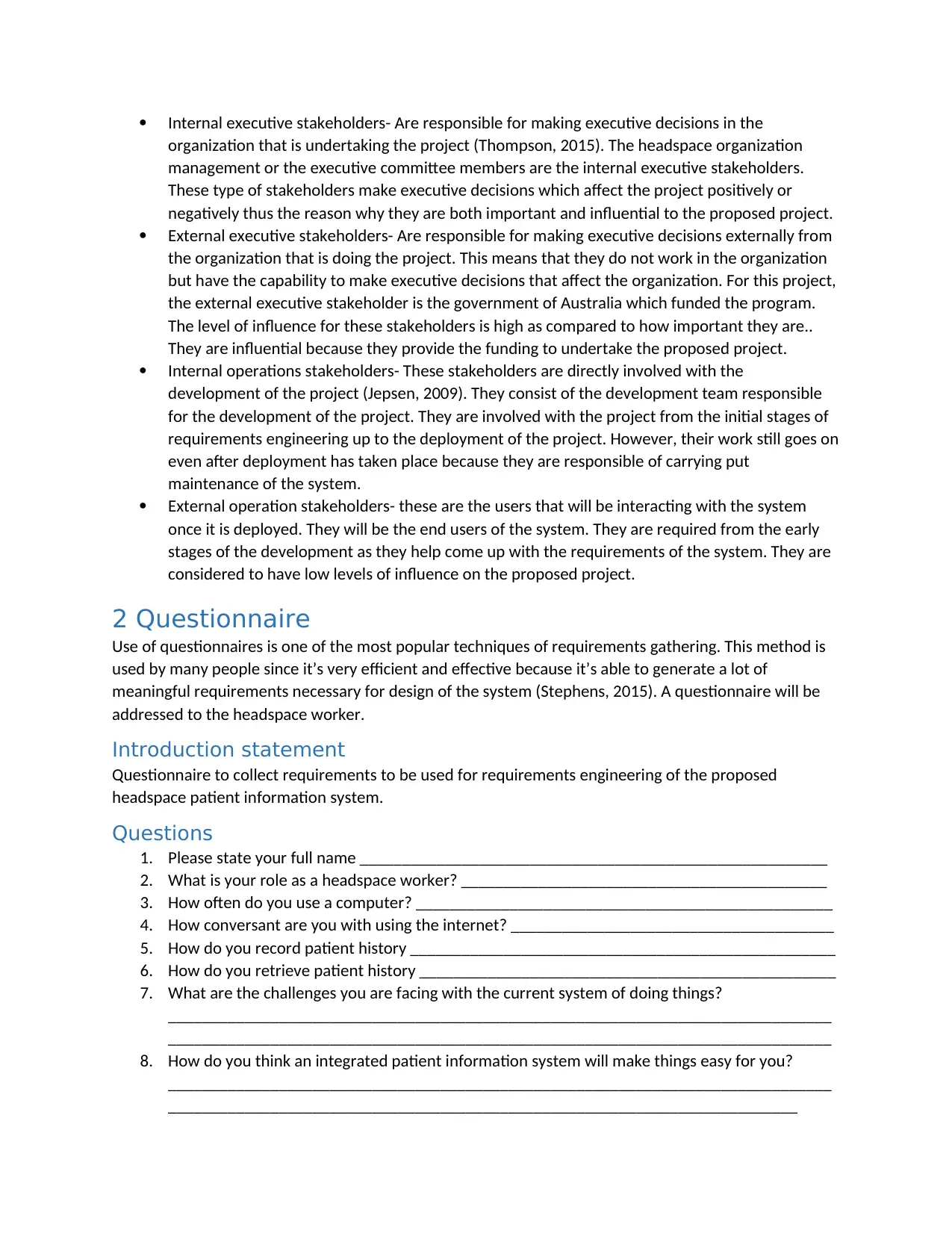
Internal executive stakeholders- Are responsible for making executive decisions in the
organization that is undertaking the project (Thompson, 2015). The headspace organization
management or the executive committee members are the internal executive stakeholders.
These type of stakeholders make executive decisions which affect the project positively or
negatively thus the reason why they are both important and influential to the proposed project.
External executive stakeholders- Are responsible for making executive decisions externally from
the organization that is doing the project. This means that they do not work in the organization
but have the capability to make executive decisions that affect the organization. For this project,
the external executive stakeholder is the government of Australia which funded the program.
The level of influence for these stakeholders is high as compared to how important they are..
They are influential because they provide the funding to undertake the proposed project.
Internal operations stakeholders- These stakeholders are directly involved with the
development of the project (Jepsen, 2009). They consist of the development team responsible
for the development of the project. They are involved with the project from the initial stages of
requirements engineering up to the deployment of the project. However, their work still goes on
even after deployment has taken place because they are responsible of carrying put
maintenance of the system.
External operation stakeholders- these are the users that will be interacting with the system
once it is deployed. They will be the end users of the system. They are required from the early
stages of the development as they help come up with the requirements of the system. They are
considered to have low levels of influence on the proposed project.
2 Questionnaire
Use of questionnaires is one of the most popular techniques of requirements gathering. This method is
used by many people since it’s very efficient and effective because it’s able to generate a lot of
meaningful requirements necessary for design of the system (Stephens, 2015). A questionnaire will be
addressed to the headspace worker.
Introduction statement
Questionnaire to collect requirements to be used for requirements engineering of the proposed
headspace patient information system.
Questions
1. Please state your full name _______________________________________________________
2. What is your role as a headspace worker? ___________________________________________
3. How often do you use a computer? _________________________________________________
4. How conversant are you with using the internet? ______________________________________
5. How do you record patient history __________________________________________________
6. How do you retrieve patient history _________________________________________________
7. What are the challenges you are facing with the current system of doing things?
______________________________________________________________________________
______________________________________________________________________________
8. How do you think an integrated patient information system will make things easy for you?
______________________________________________________________________________
__________________________________________________________________________
organization that is undertaking the project (Thompson, 2015). The headspace organization
management or the executive committee members are the internal executive stakeholders.
These type of stakeholders make executive decisions which affect the project positively or
negatively thus the reason why they are both important and influential to the proposed project.
External executive stakeholders- Are responsible for making executive decisions externally from
the organization that is doing the project. This means that they do not work in the organization
but have the capability to make executive decisions that affect the organization. For this project,
the external executive stakeholder is the government of Australia which funded the program.
The level of influence for these stakeholders is high as compared to how important they are..
They are influential because they provide the funding to undertake the proposed project.
Internal operations stakeholders- These stakeholders are directly involved with the
development of the project (Jepsen, 2009). They consist of the development team responsible
for the development of the project. They are involved with the project from the initial stages of
requirements engineering up to the deployment of the project. However, their work still goes on
even after deployment has taken place because they are responsible of carrying put
maintenance of the system.
External operation stakeholders- these are the users that will be interacting with the system
once it is deployed. They will be the end users of the system. They are required from the early
stages of the development as they help come up with the requirements of the system. They are
considered to have low levels of influence on the proposed project.
2 Questionnaire
Use of questionnaires is one of the most popular techniques of requirements gathering. This method is
used by many people since it’s very efficient and effective because it’s able to generate a lot of
meaningful requirements necessary for design of the system (Stephens, 2015). A questionnaire will be
addressed to the headspace worker.
Introduction statement
Questionnaire to collect requirements to be used for requirements engineering of the proposed
headspace patient information system.
Questions
1. Please state your full name _______________________________________________________
2. What is your role as a headspace worker? ___________________________________________
3. How often do you use a computer? _________________________________________________
4. How conversant are you with using the internet? ______________________________________
5. How do you record patient history __________________________________________________
6. How do you retrieve patient history _________________________________________________
7. What are the challenges you are facing with the current system of doing things?
______________________________________________________________________________
______________________________________________________________________________
8. How do you think an integrated patient information system will make things easy for you?
______________________________________________________________________________
__________________________________________________________________________
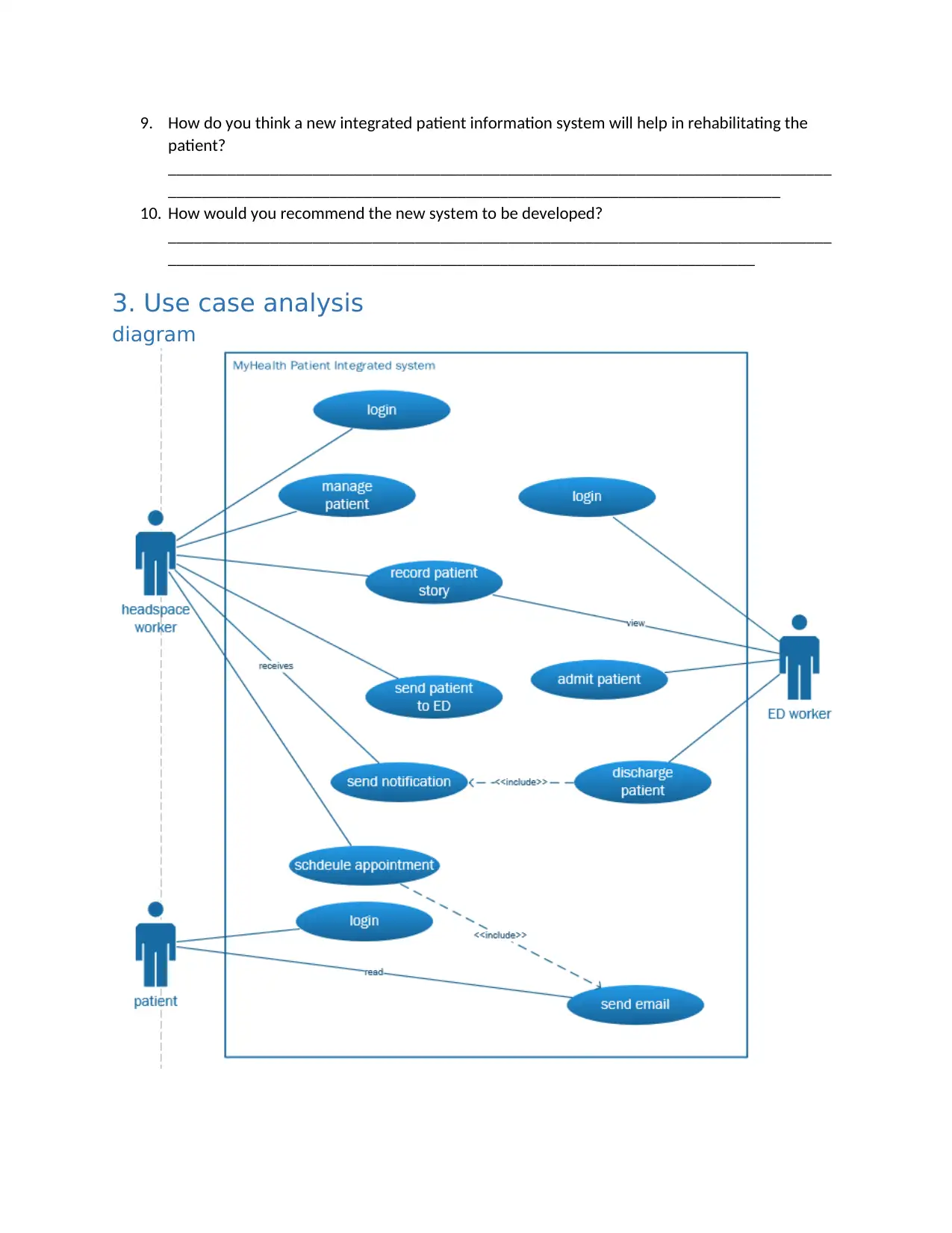
9. How do you think a new integrated patient information system will help in rehabilitating the
patient?
______________________________________________________________________________
________________________________________________________________________
10. How would you recommend the new system to be developed?
______________________________________________________________________________
_____________________________________________________________________
3. Use case analysis
diagram
patient?
______________________________________________________________________________
________________________________________________________________________
10. How would you recommend the new system to be developed?
______________________________________________________________________________
_____________________________________________________________________
3. Use case analysis
diagram
⊘ This is a preview!⊘
Do you want full access?
Subscribe today to unlock all pages.

Trusted by 1+ million students worldwide
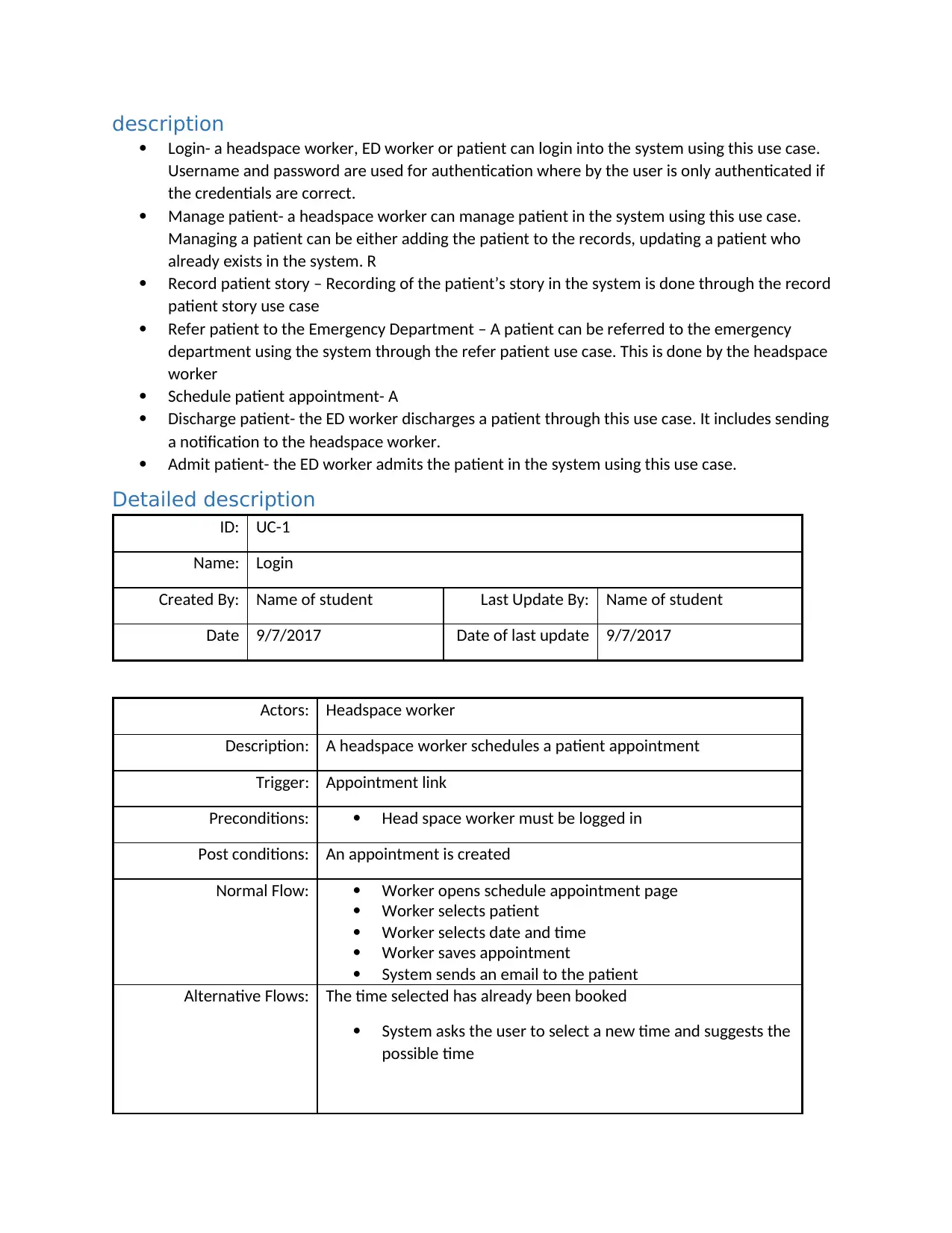
description
Login- a headspace worker, ED worker or patient can login into the system using this use case.
Username and password are used for authentication where by the user is only authenticated if
the credentials are correct.
Manage patient- a headspace worker can manage patient in the system using this use case.
Managing a patient can be either adding the patient to the records, updating a patient who
already exists in the system. R
Record patient story – Recording of the patient’s story in the system is done through the record
patient story use case
Refer patient to the Emergency Department – A patient can be referred to the emergency
department using the system through the refer patient use case. This is done by the headspace
worker
Schedule patient appointment- A
Discharge patient- the ED worker discharges a patient through this use case. It includes sending
a notification to the headspace worker.
Admit patient- the ED worker admits the patient in the system using this use case.
Detailed description
ID: UC-1
Name: Login
Created By: Name of student Last Update By: Name of student
Date 9/7/2017 Date of last update 9/7/2017
Actors: Headspace worker
Description: A headspace worker schedules a patient appointment
Trigger: Appointment link
Preconditions: Head space worker must be logged in
Post conditions: An appointment is created
Normal Flow: Worker opens schedule appointment page
Worker selects patient
Worker selects date and time
Worker saves appointment
System sends an email to the patient
Alternative Flows: The time selected has already been booked
System asks the user to select a new time and suggests the
possible time
Login- a headspace worker, ED worker or patient can login into the system using this use case.
Username and password are used for authentication where by the user is only authenticated if
the credentials are correct.
Manage patient- a headspace worker can manage patient in the system using this use case.
Managing a patient can be either adding the patient to the records, updating a patient who
already exists in the system. R
Record patient story – Recording of the patient’s story in the system is done through the record
patient story use case
Refer patient to the Emergency Department – A patient can be referred to the emergency
department using the system through the refer patient use case. This is done by the headspace
worker
Schedule patient appointment- A
Discharge patient- the ED worker discharges a patient through this use case. It includes sending
a notification to the headspace worker.
Admit patient- the ED worker admits the patient in the system using this use case.
Detailed description
ID: UC-1
Name: Login
Created By: Name of student Last Update By: Name of student
Date 9/7/2017 Date of last update 9/7/2017
Actors: Headspace worker
Description: A headspace worker schedules a patient appointment
Trigger: Appointment link
Preconditions: Head space worker must be logged in
Post conditions: An appointment is created
Normal Flow: Worker opens schedule appointment page
Worker selects patient
Worker selects date and time
Worker saves appointment
System sends an email to the patient
Alternative Flows: The time selected has already been booked
System asks the user to select a new time and suggests the
possible time
Paraphrase This Document
Need a fresh take? Get an instant paraphrase of this document with our AI Paraphraser
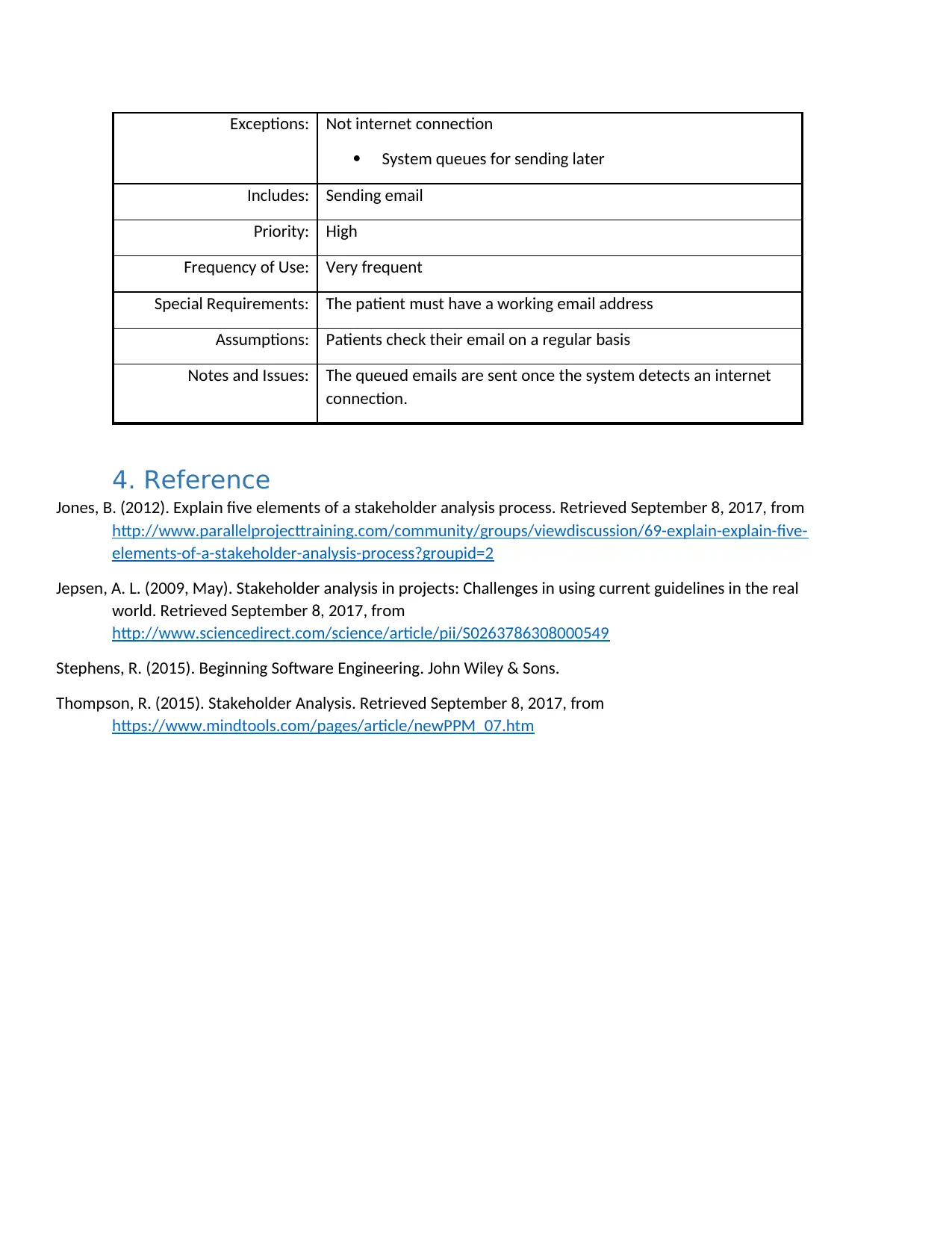
Exceptions: Not internet connection
System queues for sending later
Includes: Sending email
Priority: High
Frequency of Use: Very frequent
Special Requirements: The patient must have a working email address
Assumptions: Patients check their email on a regular basis
Notes and Issues: The queued emails are sent once the system detects an internet
connection.
4. Reference
Jones, B. (2012). Explain five elements of a stakeholder analysis process. Retrieved September 8, 2017, from
http://www.parallelprojecttraining.com/community/groups/viewdiscussion/69-explain-explain-five-
elements-of-a-stakeholder-analysis-process?groupid=2
Jepsen, A. L. (2009, May). Stakeholder analysis in projects: Challenges in using current guidelines in the real
world. Retrieved September 8, 2017, from
http://www.sciencedirect.com/science/article/pii/S0263786308000549
Stephens, R. (2015). Beginning Software Engineering. John Wiley & Sons.
Thompson, R. (2015). Stakeholder Analysis. Retrieved September 8, 2017, from
https://www.mindtools.com/pages/article/newPPM_07.htm
System queues for sending later
Includes: Sending email
Priority: High
Frequency of Use: Very frequent
Special Requirements: The patient must have a working email address
Assumptions: Patients check their email on a regular basis
Notes and Issues: The queued emails are sent once the system detects an internet
connection.
4. Reference
Jones, B. (2012). Explain five elements of a stakeholder analysis process. Retrieved September 8, 2017, from
http://www.parallelprojecttraining.com/community/groups/viewdiscussion/69-explain-explain-five-
elements-of-a-stakeholder-analysis-process?groupid=2
Jepsen, A. L. (2009, May). Stakeholder analysis in projects: Challenges in using current guidelines in the real
world. Retrieved September 8, 2017, from
http://www.sciencedirect.com/science/article/pii/S0263786308000549
Stephens, R. (2015). Beginning Software Engineering. John Wiley & Sons.
Thompson, R. (2015). Stakeholder Analysis. Retrieved September 8, 2017, from
https://www.mindtools.com/pages/article/newPPM_07.htm
1 out of 5
Related Documents
Your All-in-One AI-Powered Toolkit for Academic Success.
+13062052269
info@desklib.com
Available 24*7 on WhatsApp / Email
![[object Object]](/_next/static/media/star-bottom.7253800d.svg)
Unlock your academic potential
Copyright © 2020–2025 A2Z Services. All Rights Reserved. Developed and managed by ZUCOL.





